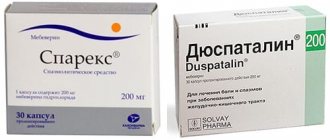Difference between Omez and Omeprazole
There are slight differences between the drugs, but there is no difference in effectiveness (when taking the same dosages) between them, since they have the same active ingredient and the same principle of action.
Omez (Dr. Reddy's) 10 mg, 10 pieces – 80 rubles.
Omez (Dr. Reddy's) 20 mg, 30 pieces - 196 rubles.
Prices for Omeprazole
Omeprazole (OZONE) 20 pieces, 20 mg – 40 rubles.
Omeprazole-Richter (GEDEON RICHTER) 20 mg, 28 capsules - 167 rubles.
Omeprazole Akrikhin (Akrikhin) 20 mg 30 pieces – 68 rubles.
Omez is a more expensive substitute (generic) of Omeprozole. At the time of writing, the price of Omez (from the manufacturer - Dr. Reddy's) for 30 pieces (20 mg) is 196 rubles.
The price of Omeprazole depends on the manufacturer, the minimum price is 40 rubles (20 pieces, 20 mg) manufacturer - OZONE.
Stomach diseases are considered one of the most common ailments today. Unhealthy food, damaged ecology and constant stress do not affect us in the best way, and therefore this problem is observed in almost all countries of the world: both adults and children suffer from it. A lot of effort has been devoted to the fight against this disease; modern medicine, in collaboration with pharmacology, is developing new and new means that are designed to alleviate the condition of patients suffering from stomach ulcers, gastritis, esophagitis, pancreatitis and other acid-dependent diseases associated with increased synthesis of aggressive hydrochloric acid by stomach cells . And one of them is Omeprazole (or Omez). Today we will try to find out what the difference between them is.
Omeprazole is the active ingredient of drugs from the group of first-generation proton pump inhibitors. When it enters our body, it quickly rushes into the acid-producing cells of the gastric mucosa. Accumulating in these cells, the drug slows down the production of hydrochloric acid, resulting in a decrease in the level of acidity in the stomach.
And the absence of an acidic environment is an excellent prerequisite for the restoration of the mucous membrane, for the healing of erosions and for the scarring of ulcers, as well as for the effective effect of antibiotics on the microbes Helicobacter pylori. Omeprazole allows you to quickly relieve the symptoms of the disease, increase the degree of healing of the mucous membrane and reduce the likelihood of developing gastric bleeding.
The original drug, which included omeprazole, is the expensive Losek (manufacturer: Astra). It was released onto the pharmacological market back in 1989. Due to its excellent clinical effect, other pharmaceutical companies began to create their own drugs - original copies (generics) of Losek.
To date, their list in pharmacies is strikingly diverse: Ultop, Cisagast, Zerotsid, Helol, Omitox, Omizak, etc. The names of some generics contain the name of the active substance: omeprazole-Acri, omeprazole-Sandoz, omeprazole-AKOS, omeprazole-Richter, etc. All of them are successfully used in medical practice.
Omez is one of the many generics (analogues) of Losec produced in India (products of Sofarimex Industria Quimica and Farmaceutica). Like Losek, it is available in the form of capsules (differing in a variety of dosages - 10, 20 and 40 mg), which need to be swallowed, and a solution for droppers.
Omez is a generic drug in which omeprazole is an active ingredient. But experts say that the content of the active substance in analogues and in the original drug may differ. Generics include more cheap excipients (titanium dioxide, sodium hydrogen phosphate, sucrose, sodium lauryl sulfate, etc.
The goal of both medications is to suppress the hydrochloric acid produced by the stomach. This is relevant in the presence of gastritis or stomach ulcers, since the acid irritates the resulting wounds on the mucous membrane.
Omeprazole is an active substance from the group of first generation proton pump inhibitors. After entering the body, it rushes into the stomach cells that produce hydrochloric acid and slows down its production. Therefore, omeprazole quickly suppresses the symptoms of ulcers or gastritis and increases the level of healing of the mucous membrane.
The main original drug containing such an active substance as omeprazole is Losek. It first appeared in pharmacies in 1989. Currently, pharmacies have a large number of “copies” of this drug: Helol, Omitox, Omizak, Cisagast, Ultop, Omeprazole-Acri, Omeprazole-AKOS, Omeprazole-Sandoz, etc. All of them are used successfully in medical practice.
Omez is the most common analogue of omeprazole in Russia.
Both drugs are available as:
- enteric capsules 20 or 10 mg;
- tablets of 40, 20 or 10 mg;
- powder in a bottle of 40 mg.
One enteric capsule of Omez contains: 10 mg of the active substance such as omeprazole, excipients (crospovidone 5 mg, mannitol 59 mg, hypromellose 2 mg, poloxamer 1.25 mg, meglumine 0.75 mg), povidone 7 mg (K- 30) – coating. The composition of the enteric coating includes: elite acrylate copolymer 18 mg, methacrinolic acids, magnesium stearate 1 mg, triethyl citrate 1.8 mg.
Omeprazole contains in one capsule the same active substance as Omez. Excipients: granulated sugar, povidone, sodium carboxymethyl starch type A 8.40 mg, potassium oleate, titanium dioxide (E171), talc, oleic acid, sodium lauryl sulfate, hypromellose, methacrylic acid, as well as ethyl acrylate copolymer, triethyl citrate.
As for the following information, it will be identical for both the first and second drugs, since they contain the same active substance, which means the effect on the body will be the same.
Indications for use:
- stress-related ulcers:
- Zollinger-Ellison syndrome;
- peptic ulcer of the stomach and intestines;
- esophagitis (erosive-ulcerative);
- stomach or duodenal ulcer;
- pancreatitis;
- mastocytosis system;
- recurrence of gastric or intestinal peptic ulcer;
- reflux gastroesophageal disease.
To treat gastric diseases, doctors prescribe various medications, among which there are often drugs that are almost identical both in composition and in their principle of action. Let's try to find out what the difference is between Omez and Omeprazole and why specialists sometimes replace one drug with another in treatment regimens.
At the present time, stomach diseases are one of the most common. They can be caused not only by unhealthy food or poor ecology, but also by the constant stress that various categories of the modern population have to endure, regardless of the territory in which country they live.
Due to the particular spread of this problem, many pharmaceutical companies have devoted a lot of effort to developing drugs that could be used by them, if not to completely eliminate this problem, then to alleviate the condition of patients, at least. However, such a remedy was invented, it became the drug Omez, which is now being actively replaced by the same Omeprazole.
What is better to take – Omez or Omeprazole
Since the medications are similar in composition, it is impossible to say for sure which drug is better. It is necessary to focus on the patient's condition. It should be borne in mind that Omez contains lactose, a substance to which allergies are often observed. With long-term use, they often choose a cheaper medicine, such as Omeprazole.
Omez contains lactose, a substance to which allergies are often observed.
Active substance
The identical active substances that make up Omez and Omeprazole determine the therapeutic similarity of these drugs. The common component is omeprazole, which belongs to the group of proton pump inhibitors. Once in the acidic environment of the stomach, this ingredient affects the mucous membranes of the stomach.
Accumulating in the body, omeprazole reduces the production of hydrochloric acid - the main culprit of increased stomach acidity. Therefore, if you replace Omez (an analogue of Omeprazole) with another drug of similar composition, the restorative effect will be obvious: with a decrease in acidity, the walls of the digestive tract have a chance to recover and heal. The presence of omeprazole in medications as the main active ingredient reduces the risk of gastric bleeding.
Omeprazole and Omez work similarly and have the same release form - capsules. The active substance, omeprazole, enters the stomach. By combining with an acidic environment, it suppresses its effect, thereby helping to reduce the production of gastric juice. When acidity normalizes, the mucous membrane of the organ becomes covered as if with a protective film. During this time, she “rests” and recovers.
The first difference between medications is the dosage of the active component. Omeprazole contains a higher concentration of the active substance. Omez contains less omeprazole, plus some auxiliary components are added. Thanks to additional substances, the product has a gentle effect on the body and practically does not cause side effects.
The result of taking the active ingredient is noticeable within the next day.
The second difference in the action of the drugs: Omez is activated in the intestines, this factor increases its effectiveness. The medicine reduces acidity and quickly relieves gastroesophageal reflux disease.
Omeprazole, in turn, inhibits the production of gastric juice secretion. Its action begins in the stomach. The drug has a cumulative effect. After a day, the medicine forms a film on the gastric mucosa and protects it from harmful influences.
What is the difference between Omeprazole and Ultop?
The difference between Omeprazole and Omez in price is noticeable. The first drug is much cheaper - it can be purchased for 25 rubles/30 tablets of 20 mg, although from different manufacturers the cost reaches up to 95 rubles. The second remedy in the same quantity and dose costs at least 180 rubles.
The shell of the drug even contains acetic acid and many dyes. Omez’s composition is less “scary” - it only contains poloxamer, meglumine, hypromellose, mannitol and crospovidone.
Omeprazole is not available in a 10 mg dose, which may be important for some patients. The difference is that Omez has a special children’s uniform marked “insta”.
There are no differences in general contraindications between the drugs, they are the same - intolerance, pregnancy, lactation, age under 18 years. It is better to take medications under the supervision of a doctor for kidney and liver failure.
None of these medications should be taken uncontrolled without examination. They can mask the symptoms of malignant stomach diseases, so it is important to first visit a doctor and undergo the necessary procedures.
Omez is a generic drug in which omeprazole is an active ingredient. But experts say that the content of the active substance in analogues and in the original drug may differ.
Generics contain more cheap excipients (titanium dioxide, sodium hydrogen phosphate, sucrose, sodium lauryl sulfate, etc.), so they reach their maximum concentration in the blood somewhat more slowly and are eliminated from the human body more quickly.
However, the widespread use of Omeprazole analogues, including Omez, in medical practice proves their effectiveness. Both the original drug and its analogue very quickly penetrate the gastric mucosa and are then absorbed from the gastrointestinal tract into the blood, reaching maximum concentration there within an hour.
Omeprazole preparations are indicated for peptic ulcers of the stomach and duodenum in the acute stage, for reflux esophagitis, for erosive and ulcerative lesions of the stomach and duodenum, for Zollinger-Ellison syndrome.
Also in modern medical practice, Omeprazole is often used to protect the stomach when taking non-steroidal anti-inflammatory drugs, which irritate the gastric mucosa and often lead to the formation of acute ulcers and erosions.
Indications for use
Contraindications for use for Omez and Omeprazole are identical. It is not recommended to take medications in the following cases:
- pregnancy or lactation period;
- children under three years of age;
- individual intolerance to individual components.
Possible side effects of both drugs are also similar:
from the musculoskeletal system (musculoskeletal system): arthralgia - joint pain, myalgia - muscle pain, myasthenia - a disorder of neuromuscular transmission;- from the nervous system: depression, headaches, agitation, dizziness, encephalopathy;
- from the hematopoietic organs: pancytopenia - a decrease in the composition of all blood components, agranulocytosis - a decrease in the cells of their leukocyte group, leukopenia - a decrease in the number of leukocytes, thrombocytopenia - a decrease in the number of platelets;
- from the gastrointestinal tract: taste disturbance, stomatitis, jaundice, impaired liver function, dry mouth, decreased activity of gastric enzymes, flatulence, diarrhea or constipation, abdominal pain, nausea and vomiting;
- from the epithelium: itching or skin rash, alopecia - hair loss, photosensitivity - increased sensitivity to ultraviolet radiation, exudative erythema multiforme - inflammatory process of the skin;
- allergic reaction: fever, swelling, urticaria, anaphylactic shock, bronchospasm.
Other: malaise, increased sweating, blurred vision.
An overdose of drugs provokes drowsiness, dry mouth, headaches, blurred vision, confusion, nausea, tachycardia, arrhythmia.
Interaction with other drugs:
- Since omeprazole, as an active substance, reduces the production of gastric juice, therefore the availability of certain medications in the body changes. For example, taking it with a drug such as Clarithromycin leads to an increase in the concentration of both drugs in the blood, so it is necessary to reduce the dose of both drugs.
- In addition, it is necessary to avoid taking biological additives for a while. Caution should be exercised when taking iron-containing drugs such as Cyclosporine, Diazepam, etc.
Let's consider in what cases drugs are prescribed:
- It can be used not only for the treatment of pathologies, but also as a preventive measure for the development of gastritis. Capsules are prescribed if the patient takes too many tablets per day (for health reasons).
- Used for the prevention of stress ulcers as prescribed by a doctor.
- Complex therapy of inflammation of the gastric mucosa of various etiologies.
- Treatment of chronic heartburn.
- Ulcerative formations on the gastric mucosa or duodenal ulcer.
Since both drugs have the same active ingredient, Omez and Omeprazole are recommended for use for identical pathologies.
Instructions for use are almost the same. Omez and Omeprazole, as well as many of their analogues, cannot be used by people with the following factors:
- individual intolerance to active components;
- vomiting or bloody stool;
- perforation of a stomach ulcer;
- intussusception;
- the presence of a malignant neoplasm of any organ;
- bearing a child and the period of natural feeding;
- inflammation of the gastric mucosa caused by low acidity;
- children under 5 years of age - in case of urgent need, the drug is prescribed in a lower dosage.
Despite the fact that the active substance of both drugs is unable to pass into breast milk, the manufacturer nevertheless indicated this factor as a contraindication in the official annotation. The same applies to women who are carrying a baby.
The substance omeprazole has absolutely no effect on the development and health of the fetus. Therefore, Omez and Omeprazole or other analogues are still used, but only when prescribed by the attending physician.
Pharmacological action of the drug
Hemorrhoids kill the patient in 79% of cases
The medicine works as follows: the active component, under the influence of the acidic environment of the stomach, binds to the cells that are responsible for the production of hydrochloric acid. Omeprazole has an inhibitory effect on them, thus reducing the activity of these cells. Heartburn is eliminated, and the mucous membrane gets a “break” and the opportunity to recover. From the point of view of Omez consumers, compliance with the instructions for use leads mainly to positive reviews, since the drug is effective for 24 hours, that is, it is enough to take it once a day before breakfast.
Omez or Omeprazole is prescribed by a doctor in case of diseases:
- ulcers of the stomach and duodenum;
- uncomplicated heartburn;
- erosive esophagitis (before prescribing treatment, endoscopy is mandatory);
- Zollinger-Ellison syndrome;
- gastropathy that appeared while taking non-steroidal anti-inflammatory drugs;
- gastroesophageal reflux;
- also used as a prophylactic to prevent stress and aspirin ulcers.
Omeprazole is a drug that should be used with caution. Remember, you can only take it if prescribed by a doctor. Omeprazole has a number of contraindications:
- intolerance to one of the components;
- the drug is prohibited for children under 5 years of age (in especially severe cases, the doctor may prescribe Omez to the child, but the dose is calculated based on the child’s weight);
- gastritis with low acidity (since the main effect of omeprazole leads to a decrease in the production of hydrochloric acid);
- pregnancy (this drug has a negative effect on the fetus and can cause it to develop vascular pathologies);
- the period of breastfeeding (since omeprazole can be excreted through breast milk);
- oncology of the stomach and duodenum (taking the drug is prohibited even if oncology is suspected);
- osteoporosis (one of the side effects of omeprazole is the leaching of calcium from the bones).
Are there any possible side effects?
Almost all analogues can provoke the development of negative reactions. Although modern technologies allow manufacturers to minimize the appearance of possible unpleasant signs. These medications include:
- Omez D;
- Losek MAPS;
- Ultop;
- Orthanol.
Table comparing drug analogues by cost. The last data update was 10/21/2019 00:00.
- Petrov V.L., therapist. Omeprazole is an effective drug that is indicated for therapeutic and prophylactic purposes in pathologies of ulcerative etiology. I usually prescribe it to clients to reduce the production of gastric juice, since the medicine begins to act quickly, and costs much less in comparison with analogues. Most often, the drug is well tolerated by patients. In rare cases, I prescribe substitutes Ultop, Orthanol or Nexium.
- Galtseva V.P., urologist. I often prescribe Omeprazole to patients due to its antacid properties. The positive effect after taking the medicine occurs quickly. In addition, the drug is sold at an affordable price, which is important for my patients. Analogues have to be prescribed infrequently, since the occurrence of adverse reactions practically does not occur. Most often occurs in elderly patients. Then I recommend something from the new generation - Omez D or Ortanol.
The body reacts to the active substance in different ways. However, based on reviews, it can be understood that any reaction rarely occurs.
Possible manifestations include the following:
- change in stool: watery diarrhea or prolonged constipation;
- pain in the abdomen;
- nausea, which in some cases is accompanied by profuse vomiting;
- bloating and discomfort in the abdomen;
- loss of smell;
- severe dizziness;
- migraine;
- depression;
- myasthenia gravis;
- rash on the body, accompanied by severe itching.
In approximately 0.01% of cases, significant deterioration of vision and the formation of small cysts in the human stomach are possible.
If adverse reactions occur after taking Omez or Omeprazole, you must stop using the capsules and consult your doctor, who will select a substitute with a different active ingredient.
Overdose
There are no official data on drug overdoses recorded.
Even if the dosage of Omez or Omeprazole was not observed, no adverse reactions occurred in the body.
Which drug is better
It is impossible to get a definite answer to the question of which drug is better than Omez or Omeprazole, since both of these medications have certain advantages and disadvantages. In addition, according to the principle of their effect on the body and the presence of active substances, these two drugs are almost identical and do not have any fundamental differences from each other. If we consider such a criterion as cost, then in this case Omeprazole wins significantly, since its price is approximately 2 times less than the cost of Omez.
Differences between drugs
In fact, the first drug made on the basis of omeprazole and shown to work well in the treatment of stomach medications is Losek (Astra). This product first appeared on the pharmaceutical market in 1989. Due to its excellent clinical characteristics, other manufacturers began producing similar but cheaper generic drugs.
However, the price between the antiulcer analogue drugs themselves can also vary significantly. Since Omez is a product of the Indian pharmaceutical industry, it will accordingly be more expensive than Russian Omeprazole.
The treatment regimen according to which Omez or Omeprazole should be taken for gastritis or ulcers is identical:
- For manifestations of inflammatory processes in the gastrointestinal tract in the form of gastritis, accompanied by pain and increased secretion of gastric juice, gastric ulcers, the recommended dose of any of these drugs is 20 mg per day;
- In case of manifestations of Zollinger-Ellison syndrome, caused by the formation of a gastroproducing tumor, accompanied by hypersecretion of hydrochloric acid in the stomach, the dose of the active substance should be increased to 60-120 mg;
- In treatment regimens for influencing the manifestations of esophagitis, drugs are taken 1-2 capsules daily;
- It is advisable to use the medicine in the first half of the day. Taking medications Omez or Omeprazole is recommended immediately before meals with drinking plenty of water;
- The expected effect with a single use occurs 1 hour after use.
- The course of treatment is 14–28 days.
The instructions for any of the drugs in question include taking 1 capsule 3-4 hours before bedtime as a preventative measure for gastrointestinal diseases and to prevent acid aspiration.
If Helicobacter bacteria are detected in the body, Omez or Omeprazole is prescribed at a dosage of 20-40 mg in combination with amoxicillin (750 mg) twice a day for two weeks. However, for each specific case, the dosage and regimen may be changed, so in this case, consultation with a doctor is required.
If for some reason the next dose of the drug is missed, then you cannot take an increased dosage of Omez or Omeprazole at the same time.
Despite the difference between Omez and Omeprazole in the presence of additional components, the dosage of the main active ingredient in their composition is the same.
Omez capsules are hard, made of gelatin, with a transparent body and a pink cap. The capsule bears the inscription “OMEZ”. The contents of the capsules are white granular spherical powder containing the main active ingredient and auxiliary components.
Omeprazole capsules are hard capsules made of gelatin, with a white body and a red cap. Each capsule contains a granular spherical powder from white to light beige color, containing the main active ingredient and auxiliary components.
The dosages of the main active ingredient in these analogues are 10, 20 and 40 mg. Capsules are packaged in contour packaging of 10 pieces.
The answer to this question cannot be unambiguous, since Omez is, first of all, a generic drug in which Omeprazole acts as an active substance. Most often, such generics include excipients that are characterized by their low cost. A striking example of these may be the same titanium dioxide, or the equally common sodium lauryl sulfate, which is often supplemented with ordinary sucrose or sodium hydrogen phosphate.
If you believe the opinion of experts, then it should be noted that the content of the active substance may differ in the original drug and in its closest analogues, therefore, when buying them, you should be extremely careful! By the way, the above-mentioned composition of such a drug determines its relatively low cost, which, in turn, could be explained by its lack of effectiveness.
Many people believe that the similar composition of Omez and Omeprazole means that both drugs are exactly the same. This opinion is erroneous; there is still a slight difference between Omez and Omeprazole.
The third difference is that the drug Omez appeared on the pharmaceutical market much earlier. This product was developed on the basis of the Indian product “Losek”. Omez is absolutely identical to the Indian medicine, but it began to be produced in Russia, as a result of which the cost of the drug is lower.
Omeprazole was first developed on the basis of Omez, but in Belarus.
The choice between the drugs Omez or Omeprazole is of interest to those who are faced with pathologies of the gastrointestinal tract, because the instructions for use of both drugs are the same. We invite you to read the opinions of experts.
Larisa Vasilyevna Netolkaeva, gastroenterologist: “It is impossible to specifically answer this question, since Omez and Omeprazole have proven themselves positively, and both drugs are popular among doctors and consumers. Side effects are equally rare. But still, according to statistics, the drug Omeprazole causes an adverse reaction in the body somewhat more often, unlike its analogue. I prescribe Omeprazole to my patients, since it is a more modern remedy. „
Viktor Vasilyevich Kulikov, gastroenterologist: “To choose the best medicine among these and their analogues, you must first visit a doctor. Depending on the pathology and its severity, a suitable remedy is determined. Also, when choosing a drug, the individual characteristics of the body play a role. Omeprazole has a more effective effect on some people than Omez, and vice versa. Therefore, do not neglect your health and entrust it to professionals. „
https://www.youtube.com/watch?v=X-OFARB4XB4
Patient opinions
Reviews from patients indicate that both Omez and Omeprazole are equally effective. The choice of drug in a particular case is determined by the individual characteristics of the body.
My stomach hurt for a long time, but I didn’t have time to go to the hospital. She was treated at home with improvised means. After a few weeks, the pain became unbearable. I went to the doctor, had a gastroscopy, and found a stomach ulcer. The doctor said that the pathology is caused by increased acidity. Prescribed the drug Omeprazole. I drank it for a week and noticed problems with stool, constipation began. At first I did not associate this symptom with taking the medicine. I went to the hospital again, the doctor explained that constipation was a side reaction from Omeprazole. We replaced the medication with Omez. The constipation disappeared and no further reactions occurred. The ulcer was cured, or rather, brought to a long-term remission. Therefore, when asked which is better, Omez or Omeprazole, I can say that the second remedy has proven to be more effective. Irina, 37 years old
She became very ill and was immediately diagnosed with 3 chronic diseases. They prescribed a bunch of pills. On average, I took about 15 medications a day. My stomach started to hurt. The gastroenterologist advised me to drink Omeprazole so that the mucous membrane of the organ would be protected. After a few days of taking Omeprazole, the pain disappeared and did not occur again. The price of the product is very low. Good drug! Olga, 33 years old
Since my chronic gastritis periodically makes itself felt, Omeprazole is always available in the medicine cabinet. It is more effective than any painkillers. One day the pain struck at night, and the pain was unbearable. I went to a 24-hour pharmacy, but Omeprazole, which I always bought before, was out of stock. The pharmacist advised taking Omez D. Both products have the same composition, but the manufacturers are different. The only drawback is the high cost. Compare for yourself - the price is twice as high. I didn't notice any difference at all. That's why I still buy cheap Omeprazole. Nina, 45 years old
For the last 4 years I have been suffering from periodic gastritis. At first they prescribed Omeprazole, but it immediately gave me itching and rashes on my body. Over time I switched to Omez. I asked the doctor what the difference was, but he couldn’t really say. Apparently, there are still no significant differences. But personally, Omez suits me better: there are no side effects, and the pain goes away very quickly. Nikolay, 49 years old
Both drugs are equally effective. But depending on the individual reaction of the body, they affect differently. Experts advise visiting a doctor who will prescribe the appropriate remedy for a particular case.
Comparison of drugs
Both drugs belong to the same group and have the same active ingredient in their composition. But are these medications the same and can they be easily replaced with one another? To do this, let’s look at the main indicators of “Omez” and “Omeprazole” in comparison.
Manufacturer and price
As mentioned above, Omez is produced in India, its price is about 150-200 rubles per package. Omeprazole is represented on the market by several manufacturers, including Russian pharmaceutical companies, and also produced in Israel and Serbia. The price ranges from 50-100 rubles per package.
Supplements
Omeprazole contains the maximum amount of active ingredient with a minimum of additives. Omez contains a large number of excipients, which, on the one hand, mitigate side effects, on the other hand, reduce the cost of the production process and slow down the achievement of the maximum concentration of omeprazole.
Time of action
Omeprazole reaches its maximum effectiveness in about half an hour to an hour after administration, depending on the individual characteristics of the human body. Omez begins to act a little slower, an hour after ingestion. The effect of both drugs lasts the same time - twenty-four hours after administration, which significantly simplifies the dosage regimen.
Indications for use
- peptic ulcer of the stomach and duodenum, including those caused by taking medications, Helicobacter pylori bacteria, stress;
- Gastroesophageal reflux disease;
- Pancreatic adenoma is ulcerogenic;
- Systemic mastocytosis.
The list of diseases for which Omez should be used also includes pancreatitis. This does not mean, however, that Omeprazole is not used in the treatment of pancreatitis, on the contrary. But the fact is that in order to include a new disease in the list of indications for use, expensive research is required, which is not always profitable for pharmaceutical companies. Therefore, although Omeprazole is successfully used in practice in the complex treatment of pancreatitis, there is no information about this in the instructions.
Description of drugs
Omeprazole is a proton pump inhibitor and belongs to the group of antiulcer drugs. After taking this drug, it begins to actively influence the functioning of cells located in the mucous membranes of the stomach, which stimulate the release of hydrochloric acid. Due to the suppressive effect of the drug Omeprazole on the functioning of these cells, there is a significant decrease in the secretion of hydrochloric acid, due to which the level of acidity in the stomach is significantly reduced.
In addition, Omeprazole has a neutralizing effect on gastric juice, lowering its acidity level. Thanks to this, conditions are created inside the stomach that promote rapid healing of wounds, as well as small erosions. This drug is also actively used during the treatment of stomach ulcers with antibiotics.
Omez is an antiulcer drug belonging to the group of so-called proton pump inhibitors. Its active ingredient is omeprazole.










